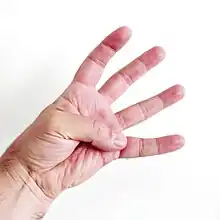ܨܒܥܬܐ
Assyrian Neo-Aramaic

ܨܒܥܬܐ
Etymology
Ultimately from Proto-Semitic *ʔiṣbaʕ-, this form being a back-formation from the plural ܨܸܒ̈ܥܵܬ݂ܵܐ (ṣibˁāṯā), a similar form also occurring in Classical Syriac ܨܸܒ݂ܥܬ݂ܵܐ (ṣeḇʿṯā), which was likewise a variant developed from ܨܸܒ݂ܥܵܬ݂ܵܐ (ṣeḇʿāṯā), the plural-formation of Classical Syriac ܨܸܒ݂ܥܵܐ (ṣeḇʿā). Ultimately from a variant of Aramaic צבעא (sˤɛbʕā) or Aramaic אֶצְבְּעָא (ʾeṣbəʿā); compare also Turoyo ܨܰܘܥܐ (ṣawco), Arabic إِصْبَع (ʔiṣbaʕ) and Hebrew אֶצְבַּע (ʾeṣbaʿ).
Pronunciation
Noun
ܨܸܒܥܬ݂ܵܐ • (ṣibˁṯā) f (plural ܨܸܒ̈ܥܵܬ݂ܵܐ (ṣibˁāṯā) or ܨܸܒ̈ܥܹܐ (ṣibˁē))
- (anatomy) finger, toe, digit
- finger (unit of measure equal to six barleycorns)
Inflection
| number | isolated forms | with possessive pronouns | |||||
|---|---|---|---|---|---|---|---|
| state | form | person | singular | plural | |||
| m | f | ||||||
| singular | absolute | – | 1st person | ܨܸܒ݂ܥܬ݂ܝܼ (ṣiḇˁṯī) |
ܨܸܒ݂ܥܬ݂ܲܢ (ṣiḇˁṯan) | ||
| construct | ܨܸܒ݂ܥܲܬ݂ (ṣiḇˁaṯ) |
2nd person | ܨܸܒ݂ܥܬ݂ܘܼܟ݂ (ṣiḇˁṯūḵ) |
ܨܸܒ݂ܥܬ݂ܵܟ݂ܝ (ṣiḇˁṯāḵ) |
ܨܸܒ݂ܥܬ݂ܵܘܟ݂ܘܿܢ (ṣiḇˁṯāwḵōn) | ||
| emphatic | ܨܸܒ݂ܥܬ݂ܵܐ (ṣiḇˁṯā) |
3rd person | ܨܸܒ݂ܥܬ݂ܹܗ (ṣiḇˁṯēh) |
ܨܸܒ݂ܥܬ݂ܵܗ̇ (ṣiḇˁṯāh) |
ܨܸܒ݂ܥܬ݂ܗܘܿܢ (ṣiḇˁṯhōn) | ||
| plural | absolute | – | 1st person | ܨܸܒ݂ܥܵܬ݂ܝܼ̈ (ṣiḇˁāṯī) |
ܨܸܒ݂ܥܵܬ݂ܲܢ̈ (ṣiḇˁāṯan) | ||
| construct | ܨܸܒ݂ܥܵܬ݂̈ (ṣiḇˁāṯ) |
2nd person | ܨܸܒ݂ܥܵܬ݂ܘܼ̈ܟ݂ (ṣiḇˁāṯūḵ) |
ܨܸܒ݂ܥܵܬ݂ܵܟ݂ܝ̈ (ṣiḇˁāṯāḵ) |
ܨܸܒ݂ܥܵܬ݂ܵܘ̈ܟ݂ܘܿܢ (ṣiḇˁāṯāwḵōn) | ||
| emphatic | ܨܸܒ݂ܥܵܬ݂ܹ̈ܐ (ṣiḇˁāṯē) |
3rd person | ܨܸܒ݂ܥܵܬ݂ܘܼ̈ܗܝ (ṣiḇˁāṯūh) |
ܨܸܒ݂ܥܵܬ݂̈ܘܿܗ̇ (ṣiḇˁāṯōh) |
ܨܸܒ݂ܥܵܬ݂ܗ̈ܘܿܢ (ṣiḇˁāṯhōn) | ||
Hyponyms
- ܟܪܵܬܵܐ (krātā, “thumb”)
- ܡܵܛܘܿܚܬܵܐ (māṭōḥtā, “forefinger, index finger”)
- ܡܸܨܥܵܝܬܵܐ (miṣˁāytā, “middle finger”)
- ܒܸܨܪܵܐ (biṣrā, “ring finger”)
- ܚܸܨܪܵܐ (ḥiṣrā, “little finger”)
Classical Syriac
Pronunciation
- IPA(key): [sˤɛvʕɑθɑ(ʔ)]
This article is issued from Wiktionary. The text is licensed under Creative Commons - Attribution - Sharealike. Additional terms may apply for the media files.